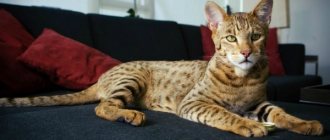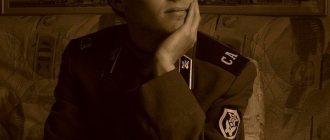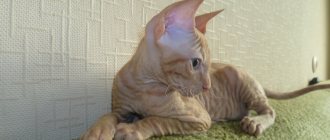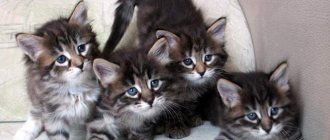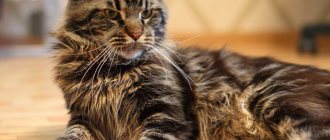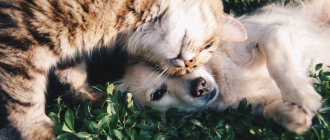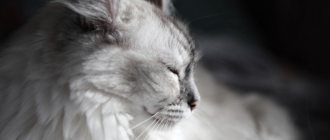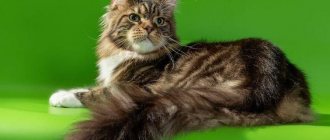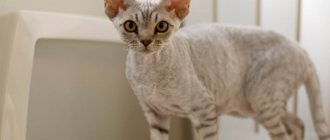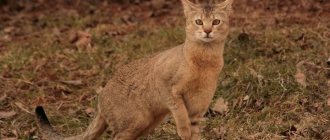Every passionate cat lover has at least once dreamed of petting a Siberian leopard, or cuddling with the soft skin of a leopard, or hugging a tiger.
But, unfortunately, wild representatives of the cat family are unlikely to allow such familiar treatment. Fortunately, there are cute domestic cats who are always happy to be petted by their owner. In addition, even among pets, you can always choose a compromise option, somewhat reminiscent of a large wild animal, if you focus on one of the really large breeds.
Chartreuse (or Carthusian cat)
Males of this breed can reach a weight of 9 kg, and females - 5 kg, height at the withers - up to 30 cm.
Chartreux is one of the oldest breeds of French domestic cats with short or semi-long gray-blue hair and amber eyes. The ancestors of modern representatives were taken from the countries of the Middle East. At first, Carthusians were bred mainly in the monasteries of the Catholic order with the same name, and the breed reached the peak of its popularity in the 1920s. However, over time, interest in Chartreuse waned, and now they have become so rare that they have become a real exclusive.
Externally, Carthusians are very similar to British Shorthair cats. But, unlike the British, Chartreuse have a more graceful and somewhat elongated head shape, as well as a much denser and longer undercoat.
By nature, Chartreuse cats are reserved and silent, calm and delicate. They are not very sociable, independent, prefer to observe what is happening from the outside and avoid open conflicts. Carthusians easily get along with everyone in the household, including other pets, but they especially highly value the attention of the owner and his desire to provide the furry pet with the most comfortable existence.
Keeping these cats is not at all difficult if you choose the right food and monitor your pet’s oral hygiene, since Chartreuse cats are prone to the formation of tartar.
Can street kittens be like the British?
In childhood, all babies are similar to each other. Of course, if you place a mongrel cat next to a Briton, the difference between them will be visible to the eye. But it is almost impossible to distinguish a litter, especially if the kittens come from short-haired parents, without the help of a specialist for the following reasons:
- All newborn kittens are fluffy. Later they will be divided into short- and long-haired, but at first they all have the same coat.
- Characteristic breed features, for example, round cheeks, are almost invisible at an early age.
- There is always a risk of giving birth to mestizo (a cross between British and outbred cats) - in this case, the chances are halved.
Chausie (or houseie)
Cats of this breed often reach a weight of 10-15 kg, height at the withers - up to 40 cm.
For the first time, kittens of this breed were obtained by crossing a wild jungle cat and an Abyssinian cat in the late 1960s. However, Chausie received recognition from felinologists only in 1995. Today, representatives of this breed are very common in the homeland of its origin - in the USA. However, in Europe, the Hausi remain a rarity to this day.
From their wild ancestors, the Chausie inherited remarkably long and slender limbs, a small, graceful head and a muscular torso. Their short coat usually comes in three main colors according to breed standards: black, ticked tabby and silver.
By nature, Hausi are very active, playful and curious. Therefore, you need to play and walk with them a lot, especially since these cats get used to walking on a leash very well. Chausies really need communication with the owner and the rest of the household, and therefore do not tolerate loneliness well. If it is not possible to spend most of the day with your pet, then he should buy a pair for company or also keep a small breed dog in the house.
When arranging a space for keeping them, Hausi owners should take into account the high activity of these creatures. The house must be equipped with special shelves and vertical scratching posts, tunnels and ropes. It is worth taking into account that cats love to climb on cabinets and then watch from above everything that happens in the room. If there is not enough space in your home, then you should prepare for the fact that the animal will become bored and begin to damage furniture or things.
Coat color
The American Shorthair cat comes in more than 80 colors. You can find any desired color - single-color, three-color, striped, etc.
Plain
Let's say red, otherwise they call it red. A solid blue American Shorthair cat is shown in the photo. There are cream, black and white shades. Pure colors do not appear so often, so they are highly valued.
Tabby
Often tortoiseshell tabby, brown tabby (pictured), etc. appear in the litter. Tabby colors include clear stripes, narrow short stripes, wide more diffuse stripes, or only markings on the forehead.
In English, tabby means “motley” or “striped.” The tabby color is considered the oldest. It appeared naturally as a method of camouflage for wild cats. The tabby's fur allowed predators to hide in the bushes and then attack their prey unnoticed.
Marble
The American Shorthair cat is famous for its silver tabby color (pictured). This is the color you can see in the Whiskas advertisement. There are clearly visible stripes here that resemble marble stains. They are more chaotic than the parallel brindles of other breeds.
Spotted (tri-color)
The photographs clearly show 3 main shades. Sometimes two mixed shades are found, but more often spotted cats are born tri-colored.
Interesting!
Often tricolor cats are females.
British shorthair cat
Cats of this breed can reach a weight of 7 kg, cats weigh slightly less - up to 5 kg. At the withers, adult animals reach a height of 30–40 cm.
The British are a very old breed, appearing in Europe during the Roman colonization, when legionnaires led by Julius Caesar reached the shores of modern Great Britain, bringing with them not only household items, but also pets. Subsequently, Roman cats crossed with local British cats and laid the foundation for a new breed.
The appearance of the British is truly regal. These stocky creatures are distinguished by a powerful torso and a large, round head with expressive amber eyes. In addition to the popular gray-blue color, the fur of a British cat can also be white, black or lilac.
By character, the British are quite consistent with their name, distinguished by equanimity, restraint in the expression of feelings and even some arrogance. They do not require much attention and tolerate loneliness well, but at the same time remain sociable and friendly. The British are almost never intrusive or aggressive. When it is necessary to attract attention to themselves, they almost never use their voice, limiting themselves only to a close, long gaze.
There are no particular difficulties in maintaining the British. It is enough just to stimulate your pet's activity from time to time, without allowing him to lie on a soft sofa all day and gain weight. The cat's thick coat also requires some attention. It needs to be combed occasionally so that the animal maintains an attractive appearance even during seasonal molting.
Pixie-bob (or short-tailed elf)
The largest representatives of the breed can reach a weight of 7 kg (for cats) and have a height at the withers of about 35 cm.
Short-tailed elves appeared in the 1980s, when felinologists crossed an ordinary domestic cat with a wild short-tailed cat. As a result, unusually large kittens were born, very similar in color and build to a small lynx. In 1995, the breed was officially registered.
The features of short-tailed elves, in addition to the incredible external resemblance to a real lynx, include polydactylism, meaning that each paw of the animal can have up to 7-8 fingers, as well as a shortened tail and charming tufts on the ears.
In the behavior of pixie bobs, many traits can be traced that are more characteristic of a dog than of a cat. They are also incredibly loyal to one owner, but at the same time they are kind to other family members, pets and strangers. Elves show aggression extremely rarely and only in response to rough treatment.
Pixie bobs are quite active and playful creatures, which, combined with their large size, can become a problem when kept in a small room. In addition, the animal's fluffy fur requires regular care.
Norwegian Forest Cat
Males of this breed reach a weight of 9 kg, females - 5.5 kg, height at the withers - up to 40 cm.
The Norwegian Forest Cat is one of the oldest Scandinavian breeds, whose ancestors were brought to Northern Europe back in the 16th century. It is believed that these were Angora cats, which over time acquired thicker and denser fur under the influence of the harsh northern climate. In addition, the changed habitat also affected the proportions of the limbs, which became more reminiscent of a lynx, allowing the animals to climb trees without problems.
Inexperienced cat lovers often confuse Norwegians with Maine Coons or the Siberian breed. However, an experienced felinologist will immediately say that they are distinguished by a triangular head shape and widely set ears that continue the line of their cheekbones. In addition, they are somewhat smaller in size, and gain external “weight” due to their pronounced undercoat.
Savannah
This breed is considered one of the largest in the world. The weight of cats reaches 10 kg, and their height at the withers is 50 cm.
Savannah will appeal to all lovers of wild cats, as it came from the union of the wild African serval with domestic cats of the Siamese, Bengal and Oriental breeds, as well as the Egyptian Mao. As a result of numerous crossings, the producers received an amazing creature with the appearance of a wild animal and the character of a pet.
The presence of wild ancestors is clearly visible in the appearance of the savannah. She has an oblong body, long limbs and neck, a small, elongated head and a characteristic spotted coat color.
The character of the pet still retains some of the habits of a predator. The animal has a pronounced hunting instinct, which is manifested in its high activity and lively mind. Therefore, to keep such an unusual representative of domestic cats, sufficient space and multi-level play complexes are required. A fenced area around the house is ideal for releasing accumulated energy.
The peculiarity of keeping savannas, in addition to sufficient space, is their increased sensitivity to low temperatures. The animal's ancestors are accustomed to a hot climate, and therefore easily catch cold in cold drafts or after walking in subzero air temperatures.
Differences in habits and behavior
Differences in appearance are not the only way to recognize representatives of different cat breeds, in our case – British and Scottish. There are also many differences in the behavior of pets. Both have special habits that distinguish one breed from another.
Many cat lovers even choose the breed of their pet not based on external differences, but on character. During the process of evolution, animals developed behavioral habits. The behavior of animals largely depends on the conditions in which their ancestors grew up.
Behavior and sociability
The British are true aristocrats. In games, they prefer to be carried in their arms, but they themselves are reluctant to run after a bow. Their massive body structure is not adapted to fast movement, but they can jump high.
The Scots are a completely different matter. They enjoy spending time with children if they are in the house. They also get along well with other pets, even if there is a dog in the house. The Scots are very active, inquisitive and ready to play with children all day long.
The British, on the contrary, are unsociable and love solitude - this is a difference in their character.
However, they are flexible. If you take your pet in your arms at the moment when he wants to be alone, he will not show aggression and try to escape, and even more so, he will not scratch you. He will endure until you get tired of your pet’s passivity and you leave him alone. In this case, he will rather hasten to hide from the excessive attention of his owners.
Special habits
The Scots have a special habit of standing on their hind legs. One such behavior for a graceful animal is a necessity that has formed over many centuries of development. In this way, your pet stretches its back and puts its vertebrae in order.
Another difference in the behavior of the Scots is “sitting on its butt” : the animal bends one leg and sits on the thigh of the other leg. Their relatives lack these two features.
Relation to height
Even things that for all members of the cat family can distinguish representatives of two related breeds. Strange is the fact that Scots are afraid of heights. These animals very rarely climb high, although academics cannot find a rational explanation for this difference.
British women, on the contrary, love to jump on high cabinets. Their torso allows them to push off the floor strongly and climb high. They usually do this in order to hide from everyone and get a good night's sleep. The difference between British women is their love of silence.
Source
Kurilian Bobtail
The weight of an adult animal of this breed often reaches 10 kg, and the height at the withers is 27–30 cm.
The Kuril Bobtail appeared on the Kuril Islands in the wild, but thanks to its friendly disposition, it quickly took root with people and gradually turned into a pet. As an independent breed, the Kurilian Bobtail was registered in 1970 as a hybrid of the Japanese Bobtail and the Siberian cat.
The appearance of the Kuril Bobtail has two main features: bob tail, as well as powerful and long hind limbs. The color of the coat is very diverse, and the length can vary from short to semi-long. The tail has a pom-pom and is between 3 cm and 8 cm long and should have bends and creases.
The character of bobtails, unlike some other large breeds, is incredibly friendly and completely non-aggressive. At the same time, the animals are active and curious, devoted to their owner and very talkative. They are excellent hunters, are not at all afraid of water and cold, love to fish and travel with their family. Despite their sociability, bobtails are quite self-sufficient and do not need increased attention from the owner. In addition, they are smart, quickly learn new things and know how to find innovative solutions in difficult situations.
Caring for bobtails is very simple and only includes regular grooming, proper high-protein nutrition, and sufficient space for play.
Hereditary diseases
The American Shorthair cat is in excellent health. It easily adapts to any conditions. When closely related or incorrect crossing occurs, genetic abnormalities appear.
Hypertrophic cardiomyopathy
Heart problems are often fatal. Therefore, it is important to regularly visit the veterinarian and monitor the animal’s condition.
A brief description of the disease is thickening of the muscular wall of the ventricles of the heart. Pathology complicates the work of the heart. In the early stages, the deviation is difficult to identify; it is practically not diagnosed. An American shorthair cat, as reviews advise, should undergo a heart ultrasound twice a year.
Symptoms:
- shortness of breath - rapid breathing with an open mouth;
- blood clot formation;
- blockage of blood vessels;
- Often problems begin with the femoral arteries, due to which the animal cannot lean on its hind limbs.
Hip dysplasia
Rare hereditary pathology. The disease provokes pain, the animal begins to limp. The pet avoids active movements, the gait becomes uncertain. He cannot jump on the sofa, chair, bed. Painful symptoms are often accompanied by desperate meowing.
Important!
The pathology is not only inherited, but also manifests itself in overweight animals.
Young pets are prescribed surgery. At the same time, the animal’s diet is adjusted, vitamins, painkillers and anti-inflammatory drugs are prescribed.
Polycystic kidney disease
This is the formation of cavities inside the organ, which are gradually filled with fluid. The disease progresses slowly. By the time it is discovered, organs often fail.
It is important to identify symptoms early:
- lethargy;
- refusal to eat and lack of appetite;
- constant thirst;
- frequent trips to the toilet;
- vomit;
- reduced weight.
To identify pathology, blood and urine tests are performed, and an ultrasound examination is additionally performed.
Treatment consists of a diet that excludes protein and phosphorus. A course of vitamins is prescribed. Antacids are prescribed to prevent gagging. Check your blood pressure regularly.
Obesity
Cats like to eat more than they need, which is why they become obese. As a result, problems with the cardiovascular system, diabetes or urolithiasis develop.
Causes of obesity:
- regular overeating;
- mixed type of feeding;
- passive lifestyle, the cat does not waste energy;
- harmful high-calorie treats;
- advanced age;
- castration (the procedure reduces the need for energy, but the animal continues to be fed in the same way).
A veterinarian will help you cope with the problem. He will select a suitable diet and check the animal for concomitant pathologies. The owner, in turn, must guarantee the pet physical activity and a healthy diet.
Maine Coon
It is this breed that first comes to mind when it comes to large cats. After all, its representatives are now at the peak of their popularity, reaching a weight of 8 kg and a height at the withers of up to 40 cm.
It is believed that Maine Coons appeared in North America as a result of crossing wild American cats and individuals brought to the continent from the Old World. Representatives of the species spread especially widely in Maine, where they became favorites of farmers, helping to protect crops and grain barns from rodents.
Breeding American Shorthair
Mating is carried out only within the breed. It is permissible to cross the American Shorthair with the Wirehaired breed.
Crossing is carried out from 8 months of age. During this time, the cat’s body will become strong enough to continue breeding. Mating is prescribed during the period of estrus, on days 1-3. The cat is always brought into the cat's territory. This way the animals will be most comfortable.
Young males are suitable for monthly mating. With age, the procedure is carried out 1-2 times a week.
The American Shorthair cat gives birth to kittens at 9-10 weeks of pregnancy. The imminent birth is signaled by the characteristic behavior of the mother cat. She will dig the ground, form a nest, and begin to look for a secluded warm place.
Important!
Despite the fact that a cat can go into heat 3-4 times a year, they should not give birth more than 2 times a year. The favorable age for the birth of offspring is up to 8-9 years.

